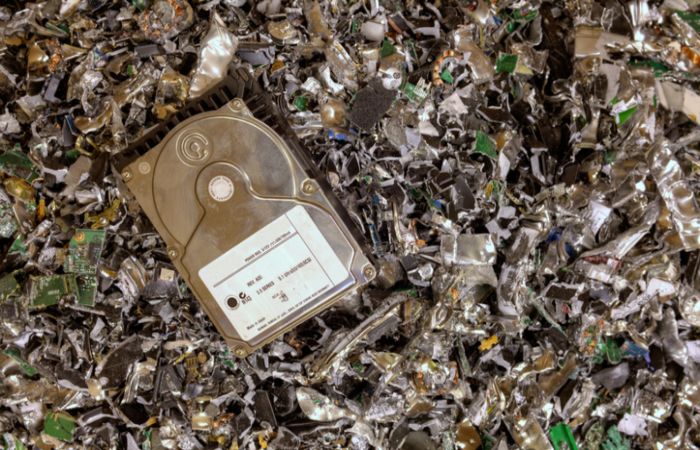Serving the Dallas Fort Worth Area & Nationwide

What Happens to E-waste When Recycled?
The rapid advancement of technology has led to an increasing amount of electronic waste (e-waste) globally. E-waste includes discarded electronic devices such as smartphones, computers, televisions, and other gadgets. Proper recycling of e-waste helps minimize environmental damage, recover valuable materials, and ensure data security. Today we will explore the journey of e-waste from collection to final processing.
Collection of E-Waste
The first step in the e-waste recycling process is the collection of discarded electronic devices. Various organizations and municipalities set up e-waste collection points, where individuals and businesses can drop off their old electronics. Some companies also offer take-back programs, encouraging customers to return their outdated devices. Effective collection ensures that e-waste is diverted from landfills and directed toward recycling facilities.
Sorting and Categorization of E-Waste
Once collected, e-waste is transported to recycling centers, where it undergoes sorting and categorization. Trained personnel and automated systems separate the e-waste into different categories based on the type of device, material composition, and potential hazards. This step is essential to ensure that each type of e-waste is processed appropriately, maximizing the efficiency of subsequent recycling stages.
Disassembly and Dismantling
In the disassembly and dismantling phase, e-waste is manually or mechanically broken down into its individual components. This stage is crucial as it sets the foundation for efficient recycling and recovery of valuable materials. The process begins with the removal of easily detachable parts such as batteries, external casings, and cables. These initial steps are often performed manually by skilled workers to ensure precision and avoid damaging sensitive components.
- Battery Removal: Batteries are one of the first components to be removed due to their potential to leak hazardous chemicals like lithium, nickel, or lead. Special care is taken to handle batteries safely, preventing short circuits or leaks. Batteries are then sorted by type and sent to facilities specializing in battery recycling.
- Circuit Boards and Chips: Once the batteries are removed, attention is turned to the internal components such as circuit boards and chips. These parts are rich in valuable metals like gold, silver, and copper. Manual disassembly is often used here to prevent breakage and ensure that valuable metals can be efficiently recovered later. Workers carefully unscrew and extract these components, which are then sent for further processing.
- Screens and Displays: Screens and displays are another critical component. Depending on the type of display—LCD, LED, or CRT—different disassembly techniques are used. For example, CRT monitors contain leaded glass and require careful handling to avoid releasing lead dust. LCDs and LEDs are dismantled to recover backlighting elements and glass.
- Mechanical Dismantling: For larger or more complex devices, mechanical dismantling may be employed. Specialized machinery can shred devices into smaller pieces, which are then sorted using automated processes like magnetic separation, eddy current separation, and optical sorting. These methods help segregate metals, plastics, and other materials efficiently.
- Sorting of Components: After disassembly, components are sorted into various categories based on material type and potential for reuse or recycling. Metals, plastics, and glass are separated and prepared for their respective recycling processes. This step ensures that each material stream is pure and free from contaminants, which enhances the efficiency and quality of material recovery in subsequent stages.
- Environmental and Safety Considerations: Throughout the disassembly and dismantling process, strict environmental and safety protocols are followed. Protective gear is worn by workers to shield them from hazardous substances. Dust extraction systems and proper ventilation are employed to minimize exposure to harmful particles. Additionally, facilities are designed to contain and manage any accidental spills or leaks of hazardous materials.
- Innovations in Dismantling: Recent advancements in e-waste recycling technology have introduced automated disassembly lines equipped with robotic arms and AI-driven sorting systems. These innovations increase the speed and accuracy of dismantling, allowing for higher volumes of e-waste to be processed efficiently. Automated systems can also handle smaller and more intricate devices, which are challenging to disassemble manually.
Recovery of Valuable Materials
One of the primary goals of e-waste recycling is the recovery of valuable materials such as gold, silver, copper, and rare earth elements. Specialized techniques, including smelting and chemical processing, are used to extract these materials from the disassembled components. Recovering these resources reduces the need for mining new materials, conserving natural resources, and lowering the environmental impact of electronic manufacturing.
Data Destruction and Security Measures
Data security is a significant concern in e-waste recycling, as discarded devices may contain sensitive personal or corporate information. Recycling facilities employ stringent data destruction protocols to ensure that all data is irretrievably erased from devices. This may involve physical destruction of storage media or secure data wiping methods, providing peace of mind to individuals and businesses.
Environmental Impact
Recycling e-waste has a profound positive impact on the environment. By diverting e-waste from landfills, harmful substances such as lead, mercury, and cadmium are prevented from leaching into the soil and water. Additionally, recycling reduces the energy consumption and greenhouse gas emissions associated with the production of new electronic devices. It also mitigates the ecological damage caused by mining activities.
Final Processing and Responsible Disposal
After valuable materials are recovered, the remaining e-waste is subjected to final processing and responsible disposal. Non-recyclable components are treated to neutralize hazardous substances before being safely disposed of in compliance with environmental regulations. Recycling facilities strive to minimize waste generation and maximize resource recovery, ensuring a sustainable approach to e-waste management.
Call Secure On-Site Shredding
When it comes to responsibly managing e-waste, Secure On-Site Shredding provides the best service to Dallas-Fort Worth and surrounding areas. We responsibly destroy and recycle hard drives, smartphones, floppy disks, backup tapes, and CDs/DVDs. Whether you’re a business needing to comply with data protection regulations or an individual seeking to protect your personal information, we have you covered. Don’t leave your data security to chance. Trust Secure On-Site Shredding for efficient, eco-friendly, and compliant destruction services. Contact us today to schedule your shredding appointment.





